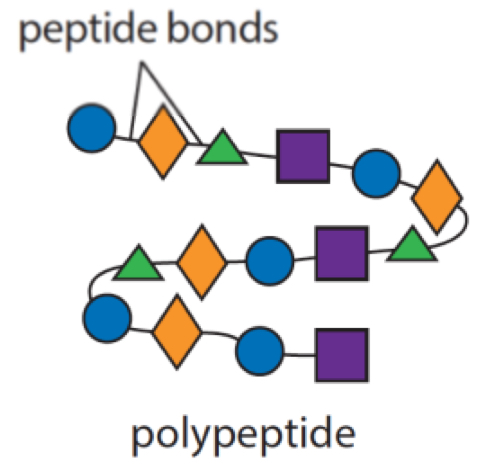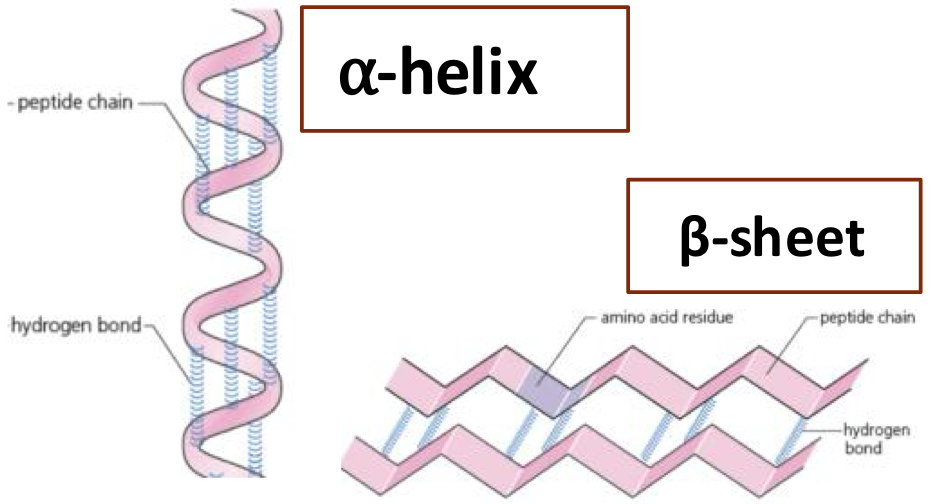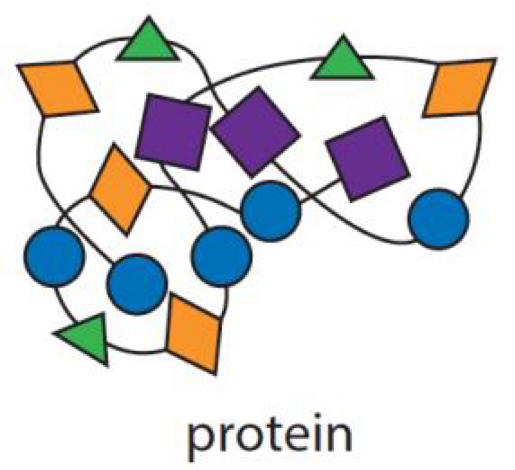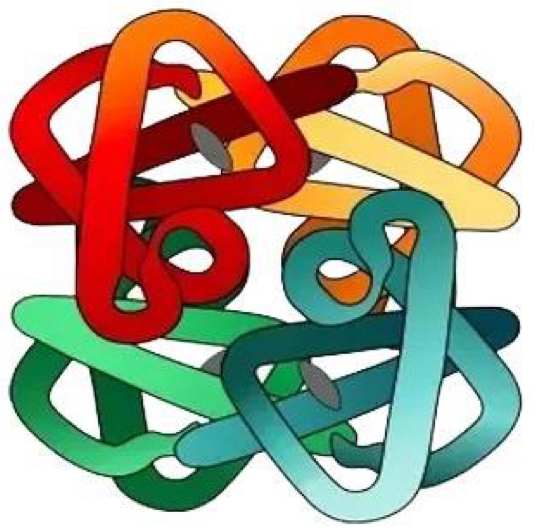biomolecules
1/28
There's no tags or description
Looks like no tags are added yet.
Name | Mastery | Learn | Test | Matching | Spaced |
|---|
No study sessions yet.
29 Terms
list the chemical elements which make up carbohydrates, fats, proteins
carbon, hydrogen, oxygen
proteins: w nitrogen
state the primary structure of proteins
the primary structure of proteins is the long chain of amino acids. proteins differ in the variety, number and order of amino acids.

state the secondary structure of proteins
the secondary structure of a protein develops when either part or all of the polypeptide chain becomes coiled to produce an α-helix or it becomes folded into β-sheets.

state the tertiary structure of proteins
the tertiary structure is the precise compact structure, unique to the protein that arises when the molecule is further folded and held in a particular complex shape. (e.g. lysozyme)

state the quaternary structure of proteins
the quaternary structure of a protein arises when two or more polypeptides become held together, forming a complex, biologically active molecule. (e.g. haemoglobin: consists of four polypeptide chains — two α-chains and two β-chains)

state the main roles of carbohydrates in living organisms
immediate source of energy
state the main roles of fats in living organisms
insulation and long-term storage of energy
state the main roles of proteins in living organisms
growth and repair of cells
describe the test for starch
add 1 drop of iodine solution on white tile.
followed by 1 drop of the test solution and mix well.
observe any colour change.
observations + conclusions
positive:
mixture turned from orange to blue-black → starch is present
negative:
mixture remained orange → starch is absent
describe the test for reducing sugars
add 1.0cm3 of test solution in a test tube.
add 1.0cm3 of Benedict’s solution to the test tube and swirl.
leave the test tube in a boiling water bath for 3 minutes.
observe for formation of precipitate
observations + conclusions
positive:
brick red precipitate was obtained from a blue mixture → a large amount of reducing sugar is present
orange precipitate was obtained from a blue mixture → a moderate amount of reducing sugar is present
yellow precipitate was obtained from a blue mixture → a low amount of reducing sugar is present
green precipitate was obtained from a blue mixture → a trace amount of reducing sugar is present
negative:
mixture remained blue. → reducing sugar is absent
describe the test for protein
add 1.0cm3 of test solution to a clean, dry test tube.
add 1.0cm3 of Biuret reagent to the test solution. shake to mix.
shake well and observe any colour change.
observations + conclusions
positive:
mixture turned from blue to violet/lilac → protein is present
negative:
mixture remained blue → protein is absent
describe the test for fats
add 2cm3 of ethanol to two drops of test solution in a test tube. mix well and allow to stand for 2 minutes.
decant the ethanol into another test tube containing 2cm3 of water. mix well.
observations + conclusions
positive:
a white emulsion was formed when water was added → fats/lipid is present
negative:
mixture remained clear when water was added → fats/lipid is absent
state that large molecules are synthesised from smaller basic units
carbs
proteins
fats
cellulose, glycogen and starch from glucose
polypeptides from proteins from amino acids
lipids such as fats from glycerol and fatty acids
explain the breakdown of starch.
amylase breaks (glycosidic) bonds between polysaccharides such as cellulose, starch, or glycogen (complex carbs), releasing maltose molecules (disaccharides). further bond-breaking by maltase (on maltose) releases individual glucose molecules (monosaccharides).
give examples of monosaccharides.
glucose
fructose
give examples of disaccharides.
maltose (glucose + glucose)
sucrose (glucose + fructose)
give examples of polysaccharides.
cellulose
starch
glycogen
describe the role of cellulose.
the cellulose cell wall protects plant cells from lysing or damage. cellulose cannot be digested in our intestines. they serve as a dietary fibre that prevents constipation.
state the occurrence of cellulose.
present in cell walls of plants
describe the role of starch.
it is the storage form of carbohydrates in plants. when needed, it can be digested to provide energy for cell activities.
state the occurrence of starch.
found in storage organs of plants (e.g. potato tubers, tapioca)
describe the role of glycogen.
it is the storage form of carbohydrates in mammals. when needed, it can be digested to provide energy for cell activities.
state the occurrence of glycogen.
stored in the liver and muscles of mammals

why are starch and glycogen suitable storage materials (of glucose)?
insoluble in water
large → cannot diffuse out of cell
compact
easily hydrolysed (broken down)
describe hydrolysis in carbs.
break down of maltose (breaking of glycosidic bond) into 2 glucose units in the presence of water.

describe condensation reaction in carbs.
two glucose units joins together to form a bigger unit (forms glycosidic bond)

explain the breakdown of fats.
fat molecule breaks down by lipase into glycerol and 3 fatty acid molecules.

describe hydrolysis in fats.
break down of fat molecule (breaking of ester bonds) for energy in the presence of water, to glycerol + 3 fatty acid molecules.

describe condensation reaction in fats.
3 fatty acid + glycerol condense to form a fat molecule and water. happens in liver and muscles
